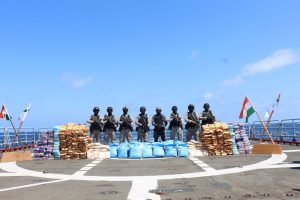India’s full membership of the multinational U.S.-led Combined Maritime Forces (CMF), announced in November 2023, represents a step change in India-U.S. ties. India’s membership in the force — commanded by a U.S. Navy vice admiral — actualizes a scenario where a senior Indian naval officer potentially co-leads one of the CMF’s five combined task forces (CTF) with an American counterpart. India’s CMF membership allows it to build the sinews required for enhanced interoperability with other members and especially the United States.
India and the United States can build on this development in two ways: map avenues for enhanced interoperability, and prioritize areas where India, the United States, and other like-minded countries can deconflict.
The Indian Navy in the Indian Ocean
In the Indian Ocean Region (IOR) — a priority area for the Indian Navy (IN) — maritime partnerships are crucial to advancing India’s security objectives. The IN has a history of independently undertaking missions. However, the IN’s recent deployment in the Gulf of Aden to deter non-state actors underlines increased realization of the importance of the IN to work closely with other maritime powers. To this end, in mid-April, the IN conducted its first-ever mission operating under a foreign flag. In its first CMF mission, the IN interdicted the narcotics trade under the CTF-150, which is led by the Canadian Navy.
Roadmap
India’s CMF membership allows it to further collaborate with other maritime powers beyond exercises. India and the United States can collaborate on two things specifically:
- Mapping Avenues for India-U.S. Interoperability
India-U.S. ties have transformed over the last two decades. Defense trade has “emerged as a central facet” and bilateral military exercises are regularly held. This progression in ties is limited by the lack of greater interoperability. Defined as the ability to “routinely act together coherently, effectively and efficiently to achieve tactical, operational and strategic objectives,” interoperability was primarily restricted to exercises, with the two states conducting joint patrols with other partners in recent years.
India’s CMF membership enables it to strengthen interoperability in ways that would be difficult to undertake even a decade ago. Both states have espoused a commitment to “enhance interoperability,” and as a member of the CMF, India has a say in the force’s operational affairs.
Per the U.S. Army, the levels of interoperability progress from deconfliction to compatible to integrated. For India and the United States to move from a deconflicted state to a more compatible one, the two states should consider mapping avenues where interoperability can be enhanced.
Given Indian sensitivities, it would be politically most feasible for both partners to focus on operations against non-state actors. The mission interdicting narcotics that the IN conducted in mid-April is a good example. This can be expanded upon by focusing on Humanitarian Assistance and Disaster Relief (HADR), Illegal, Unreported and Unregulated (IUU) fishing, and counter-piracy operations — all activities that fall, or can be placed, within the ambits of the five CTFs. With a say in the CMF’s operational affairs, the IN can push the conversation on CTFs’ mandates, aligning them with the aims identified in the IN’s 2015 Maritime Security Strategy, including an expanded area of the maritime domain, an emphasis on key maritime chokepoints, and by focusing on non-traditional threats like climate change and natural disasters.
- Prioritizing Areas for Deconflicting
Deconflicting is a first, albeit crucial step, in building interoperability. By identifying areas where the IN can lead, India and maritime partners can judiciously redirect resources in the IOR. When the IN and other navies, including the U.S. Navy, responded to the 2004 tsunami with HADR missions, deconflicting improved coordination between different navies, leading to trust-building. While that response was reactive, as a member of the CMF, India and other partners can think proactively about areas where they can deconflict.
One tangible avenue is through capacity building. India, the United States, and other countries regularly help littoral states with capacity building, and CT-151 and –153 within the CMF are mandated for the same. Given India’s experience with capacity building, it can look to expand the number of states where it helps with capacity building, by focusing on African maritime nations, and deconflict with other CMF partners that currently undertake such exercises. Developing capacity is instrumental in building regional leadership, trust-building, and crucially, is aligned with India’s stated goal of being a “net security provider.”
Ashley Tellis notes that for the United States., defense cooperation is fundamentally about “military interoperability.” Given that just a decade ago, the term “interoperability” was “anathema to Indian officials,” India’s CMF membership ought to be seen against the backdrop of evolving India-U.S. ties and the IN’s increased presence and leadership in the IOR. With India’s increasing ambitions in the maritime domain, strengthening interoperability with the United States and like-minded maritime powers, and deconflicting where possible as outlined above, is crucial. No nation can go it alone in providing regional maritime security, and while one ought to recognize and laud India’s CMF membership, the IN should further chalk out avenues for enhancing interoperability.
This article was originally published on New Perspectives on Asia from the Center for Strategic and International Studies and is reprinted with permission.

































